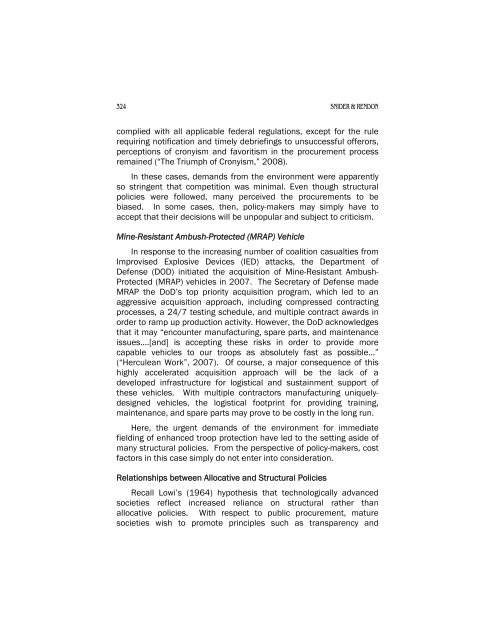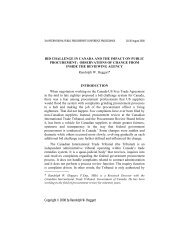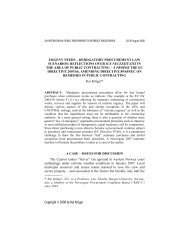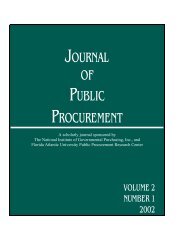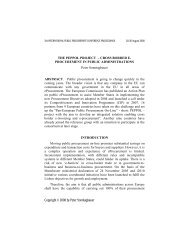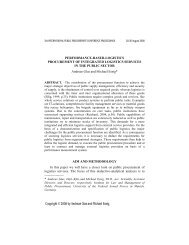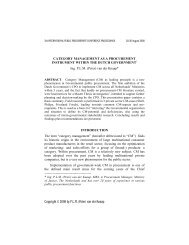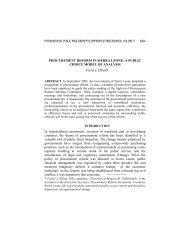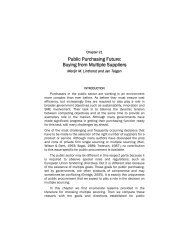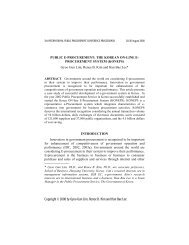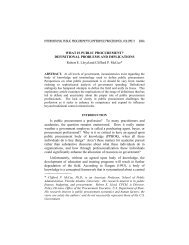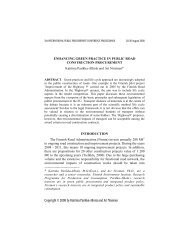Implications for Theory and Practice - ippa.org - International Public ...
Implications for Theory and Practice - ippa.org - International Public ...
Implications for Theory and Practice - ippa.org - International Public ...
Create successful ePaper yourself
Turn your PDF publications into a flip-book with our unique Google optimized e-Paper software.
324 SNIDER & RENDONcomplied with all applicable federal regulations, except <strong>for</strong> the rulerequiring notification <strong>and</strong> timely debriefings to unsuccessful offerors,perceptions of cronyism <strong>and</strong> favoritism in the procurement processremained (“The Triumph of Cronyism,” 2008).In these cases, dem<strong>and</strong>s from the environment were apparentlyso stringent that competition was minimal. Even though structuralpolicies were followed, many perceived the procurements to bebiased. In some cases, then, policy-makers may simply have toaccept that their decisions will be unpopular <strong>and</strong> subject to criticism.Mine-Resistant Ambush-Protected (MRAP) VehicleIn response to the increasing number of coalition casualties fromImprovised Explosive Devices (IED) attacks, the Department ofDefense (DOD) initiated the acquisition of Mine-Resistant Ambush-Protected (MRAP) vehicles in 2007. The Secretary of Defense madeMRAP the DoD’s top priority acquisition program, which led to anaggressive acquisition approach, including compressed contractingprocesses, a 24/7 testing schedule, <strong>and</strong> multiple contract awards inorder to ramp up production activity. However, the DoD acknowledgesthat it may “encounter manufacturing, spare parts, <strong>and</strong> maintenanceissues….[<strong>and</strong>] is accepting these risks in order to provide morecapable vehicles to our troops as absolutely fast as possible…”(“Herculean Work”, 2007). Of course, a major consequence of thishighly accelerated acquisition approach will be the lack of adeveloped infrastructure <strong>for</strong> logistical <strong>and</strong> sustainment support ofthese vehicles. With multiple contractors manufacturing uniquelydesignedvehicles, the logistical footprint <strong>for</strong> providing training,maintenance, <strong>and</strong> spare parts may prove to be costly in the long run.Here, the urgent dem<strong>and</strong>s of the environment <strong>for</strong> immediatefielding of enhanced troop protection have led to the setting aside ofmany structural policies. From the perspective of policy-makers, costfactors in this case simply do not enter into consideration.Relationships between Allocative <strong>and</strong> Structural PoliciesRecall Lowi’s (1964) hypothesis that technologically advancedsocieties reflect increased reliance on structural rather thanallocative policies. With respect to public procurement, maturesocieties wish to promote principles such as transparency <strong>and</strong>


